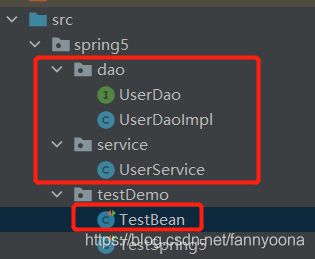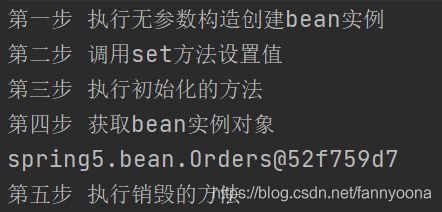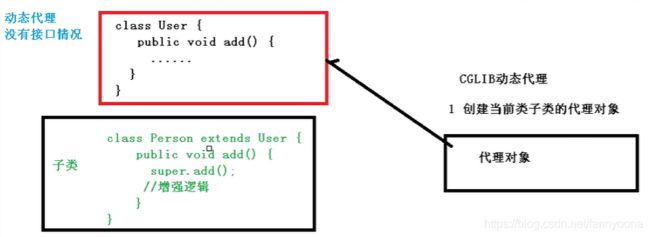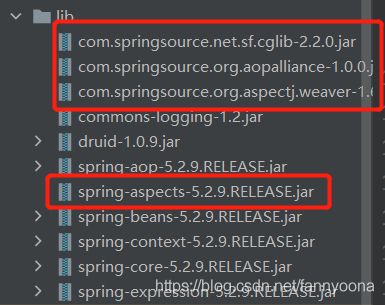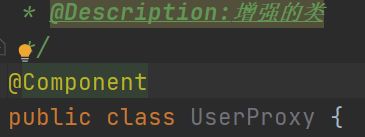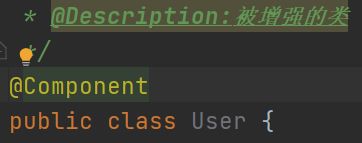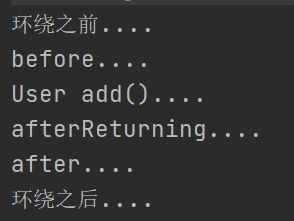Spring5框架学习笔记(上)
在此记录我初学spring的笔记,方便以后用到时查看,也分享出来给大家一起学习。参考视频教程:Spring5
从第四部分开始在:Spring5框架学习笔记(下)
笔记中所涉及到的project(用的是idea):spring5学习代码,提取码flad
Spring5学习笔记
- 一、框架概述
-
- 入门案例
- 二、IOC容器
-
- 1、IOC概念原理
- 2、IOC接口
- 3、IOC操作 Bean管理
-
-
- (1)什么是Bean管理?指的是两个操作:
- (2)Bean管理操作的几种方式
- (3)xml注入其他类型属性
- (4)注入集合类型的属性
- (5)在集合里设置对象类型值
- (6)把集合注入部分提取出来
-
- 4、IOC操作 Bean管理---FactoryBean
- 5、IOC操作 Bean管理---bean的作用域
- 6、IOC操作Bean管理---bean生命周期
- 7、IOC操作Bean管理---xml自动装配
- 8、IOC操作Bean管理---外部属性文件
- 9、IOC操作Bean管理---基于注解方式
- 三、AOP
-
- 1、概念
- 2、AOP---JDK动态代理
-
- (1)==编写JDK动态代理方法==
- (2)AOP术语
- (3)AOP操作(准备)
- (4)AOP操作(AspectJ注解)
- (5)AOP操作(AspectJ配置文件)(较少用)
- 四、JDBCTemplate
一、框架概述
- Spring是轻量级的开源的JavaEE框架,可以解决企业应用开发的复杂性
- Spring有两个核心部分:IOC和AOP
(1)IOC:控制反转,把创建对象的过程(new)交给Spring进行管理
(2)AOP:面向切面,在不修改源代码的情况下进行功能的增强
Spring框架的特点:
(1)方便解耦,简化开发
(2)AOP编程支持
(3)方便程序的测试
(4)可以方便和其他框架进行整合
(5)方便进行实事务操作
(6)降低API开发难度
spring下载地址
入门案例
1、新建java工程(maven也可以)
2、在工程下新建一个lib文件,其中加入所需要的的jar包(其中后面4个包是在前面下载的spring文件夹中可以找到的,第一个需要另外去下载,下载地址)
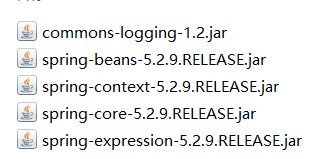
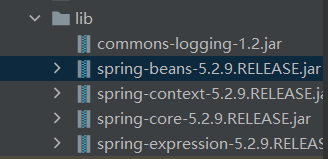
3、点Files—>project Structure,找到module,添加这几个jar包(点+后选择第一个,JARs or directions)

4、创建一个普通类,在这个类创建普通方法
public class User {
public void add(){
System.out.println("add...");
}
}
5、创建Spring配置文件,在这个类创建普通方法
(1)Spring配置文件使用xml格式
新建一个bean1.xml(名字随意)文件,选择Spring config,下面是xml文件内容
<?xml version="1.0" encoding="UTF-8"?>
<beans xmlns="http://www.springframework.org/schema/beans"
xmlns:xsi="http://www.w3.org/2001/XMLSchema-instance"
xsi:schemaLocation="http://www.springframework.org/schema/beans http://www.springframework.org/schema/beans/spring-beans.xsd">
<!-- 配置User对象创建,id是名字,class里面是路径-->
<bean id="user" class="spring5.User"></bean>
</beans>
6、测试代码编写
(这里用了junit单元测试,需要一定的基础)
package spring5.testDemo;
import org.junit.Test;
import org.springframework.context.ApplicationContext;
import org.springframework.context.support.ClassPathXmlApplicationContext;
import spring5.User;
public class TestSpring5 {
@Test
public void testAdd(){
//1.加载spring的配置文件
ApplicationContext context=
new ClassPathXmlApplicationContext("bean1.xml");
//2.获取配置创建的对象
User user=context.getBean("user", User.class);
System.out.println(user);
user.add();
}
}
二、IOC容器
1、IOC概念原理
(1)什么是IOC?
- 控制反转,把对象创建和对象之间的调用过程,交给Spring管理
- 使用IOC目的:使耦合度降低
- 上文的入门案例就是IOC实现
(2)IOC底层原理:xml解析、工厂模式、反射
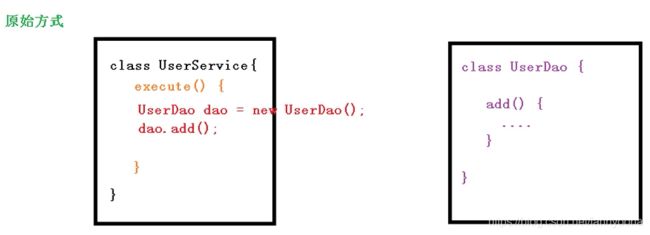
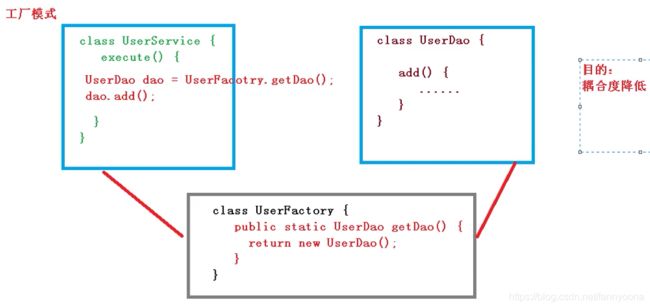
(3)IOC过程
①配置xml文件,配置创建的对象
<bean id="dao" class="xxx.UserDao"></bean> //xxx是包的名称,具体根据路径来
②有service类和dao类,创建工厂类
class UserFactory{
public static UserDao getDao(){
String classValue=class属性值;//1.xml解析得到
Class clazz= Class.forName(classValue)//2.通过反射创建对象
return (UserDao)clazz.newInstance()
}
}
2、IOC接口
(1)IOC思想基于IOC容器完成,IOC容器本质上就是对象工厂
(2)Spring提供两种IOC容器实现方式:
BeanFactory:最基本的实现方式,是Spring内部的使用接口,不提供开发人员进行使用。
*加载配置文件的时候不会创建对象,在获取对象(使用)时才创建对象。
ApplicationContext:BeanFactory接口的子接口,提供了更多更强大的功能,一般由开发人员进行使用
*加载配置文件的时候就会创建对象
(3)ApplicationContext接口的实现类
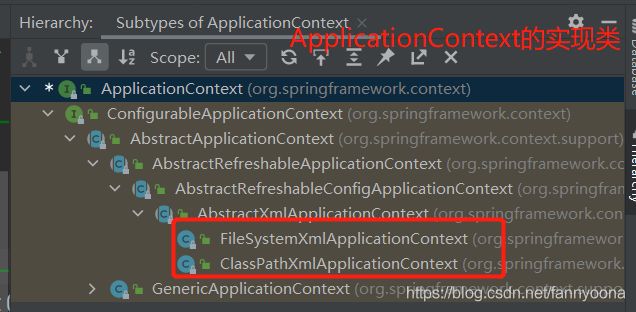
(红框中是两个主要的)
3、IOC操作 Bean管理
(1)什么是Bean管理?指的是两个操作:
- Spring创建对象
- Spring注入属性
(2)Bean管理操作的几种方式
①基于xml配置文件方式实现:
a. 在Spring配置文件中使用bean标签,标签里面添加对应属性,即可实现对象创建
b. 介绍bean标签中常用的属性:
*id属性:唯一标识(不能有特殊符号)
*class属性:类的全路径(包类路径)c. 创建对象的时候,默认是执行无参数构造方法(如果只有有参构造函数会报错)
②基于注解方式实现
a. DI:依赖注入,即注入属性
第一种注入方式:使用set方法:创建类,定义对应的属性和set方法
第二种注入方式:使用有参数的构造
set方法
public class Book {
private String bName;
private String bAuthor;
//set方法注入
public void setbName(String bName) {
this.bName = bName;
}
public void setbAuthor(String bAuthor) {
this.bAuthor = bAuthor;
}
public void testDemo(){
System.out.println(bName+"::"+bAuthor);
}
}
//xml配置部分
<bean id="book" class="spring5.Book">
<!-- 使用property完成属性注入
name:类中的属性名称
value:向属性注入的值
-->
<property name="bName" value="算法"></property>
<property name="bAuthor" value="张三"></property>
</bean>`
//测试部分
@Test
public void testBook1(){
ApplicationContext context=
new ClassPathXmlApplicationContext("bean1.xml");
Book book=context.getBean("book",Book.class);
System.out.println(book);
book.testDemo();
}
有参构造
public class Orders {
private String name;
private String address;
public Orders(String name,String address){
this.name=name;
this.address=address;
}
}
//xml配置
<bean id="orders" class="spring5.Orders">
<constructor-arg name="name" value="abc"></constructor-arg>
<constructor-arg name="address" value="china"></constructor-arg>
</bean>
(3)xml注入其他类型属性
①字面量
//null值
<property name="address">
<null/>
</property>
<!-- 属性值包含特殊符号-->
<property name="address">
<value><![CDATA[<<南京>>]]></value>
</property>
②注入属性—外部bean
a. 创建两个类service和dao
b. 在service类中调用dao里面的方法
c. 在Spring配置文件中配置
userdao接口
package spring5.dao;
public interface UserDao {
public void update();
}
接口实现
package spring5.dao;
public class UserDaoImpl implements UserDao{
@Override
public void update() {
System.out.println("dao update...");
}
}
service
package spring5.service;
import spring5.dao.UserDao;
public class UserService {
//创建UserDao属性,生成set方法
private UserDao userDao;
public void setUserDao(UserDao userDao) {
this.userDao = userDao;
}
public void add(){
System.out.println("service add......");
userDao.update();
}
}
xml配置
<!-- service和dao对象创建-->
<bean id="userService" class="spring5.service.UserService">
<!-- 注入userDao对象
name值:类里面属性名称
ref:创建userDao对象那个bean标签的id值(对应之前的value)
-->
<property name="userDao" ref="userDaoImpl"></property>
</bean>
<bean id="userDaoImpl" class="spring5.dao.UserDaoImpl"></bean>
</beans>
测试
public class TestBean {
@Test
public void test(){
ApplicationContext context=
new ClassPathXmlApplicationContext("bean2.xml");
UserService userService=context.getBean("userService",UserService.class);
userService.add();
}
}
③注入属性—内部bean
- 一对多关系:部门(一)和员工(多)
- 在实体类之间表示一对多的关系,员工的所属部门使用对象类型来表示
- 在Spring配置文件中进行配置
Dept类
package spring5.bean;
public class Dept {
private String dname;
public void setDname(String dname){
this.dname=dname;
}
}
@Override
public String toString() {
return "Dept{" +
"dname='" + dname + '\'' +
'}';
}//为了测试用的
Emp类
package spring5.bean;
public class Emp {
private String ename;
private String gender;
//员工属于某一个部门
private Dept dept;
public void setEname(String ename) {
this.ename = ename;
}
public void setGender(String gender) {
this.gender = gender;
}
public void setDept(Dept dept) {
this.dept = dept;
}
public void add(){
System.out.println(ename+":"+gender+":"+dept);
}
}
xml配置
<bean id="emp" class="spring5.bean.Emp">
<!-- 设置两个普通属性-->
<property name="ename" value="lucy"></property>
<property name="gender" value="female"></property>
<!-- 内部bean-->
<property name="dept">
<bean id="dept" class="spring5.bean.Dept">
<property name="dname" value="安保"></property>
</bean>
</property>
</bean>
④注入属性—级联赋值
<bean id="emp" class="spring5.bean.Emp">
<property name="ename" value="lucy"></property>
<property name="gender" value="female"></property>
<!-- 级联赋值-->
<property name="dept" ref="dept"></property>
</bean>
<bean id="dept" class="spring5.bean.Dept">
<property name="dname" value="caiwu"></property>
</bean>
(4)注入集合类型的属性
代码见spring5_demo2/collectiontype/Stu和spring5_demo2/bean1文件
<?xml version="1.0" encoding="UTF-8"?>
<beans xmlns="http://www.springframework.org/schema/beans"
xmlns:xsi="http://www.w3.org/2001/XMLSchema-instance"
xmlns:p="http://www.springframework.org/schema/p"
xsi:schemaLocation="http://www.springframework.org/schema/beans http://www.springframework.org/schema/beans/spring-beans.xsd">
<!-- 集合类型属性注入-->
<bean id="stu" class="spring5.Stu">
<!-- 数组类型属性-->
<property name="courses">
<array>
<value>java课程</value>
<value>数据库课程</value>
</array>
</property>
<!-- list类型属性-->
<property name="list">
<list>
<value>zhangsan</value>
<value>xiaosan</value>
</list>
</property>
<!-- map类型属性-->
<property name="maps">
<map>
<entry key="JAVA" value="java"></entry>
<entry key="PHP" value="php"></entry>
</map>
</property>
<!-- set类型属性-->
<property name="sets">
<set>
<value>MySQL</value>
<value>Redis</value>
</set>
</property>
</bean>
</beans>
(5)在集合里设置对象类型值
<!-- 注入list类型属性,值是对象-->
<property name="courseList">
<list>
<ref bean="course1"></ref>
<ref bean="course2"></ref>
</list>
</property>
<!--创建多个course对象-->
<bean id="course1" class="spring5.collectiontype.Course">
<property name="cname" value="Spring5框架课程"></property>
</bean>
<bean id="course2" class="spring5.collectiontype.Course">
<property name="cname" value="MyBatis课程"></property>
</bean>
详细见代码
(6)把集合注入部分提取出来
①在Spring配置文件中引入名称空间util
②使用util标签完成list集合注入提取
代码见spring5_demo2/collectiontype/Book和spring5_demo2/bean2文件

<?xml version="1.0" encoding="UTF-8"?>
<beans xmlns="http://www.springframework.org/schema/beans"
xmlns:xsi="http://www.w3.org/2001/XMLSchema-instance"
xmlns:util="http://www.springframework.org/schema/util"
xsi:schemaLocation="http://www.springframework.org/schema/beans http://www.springframework.org/schema/beans/spring-beans.xsd
http://www.springframework.org/schema/util http://www.springframework.org/schema/beans/spring-util.xsd">
<!-- 1 提取list集合类型属性注入-->
<util:list id="bookList">
<value>易筋经</value>
<value>九阴真经</value>
<value>九阳神功</value>
</util:list>
<!-- 2 提取list集合类型属性注入使用-->
<bean id="book" class="spring5.collectiontype.Book">
<property name="list" ref="bookList"></property>
</bean>
</beans>
4、IOC操作 Bean管理—FactoryBean
1、Spring有两种类型bean,一种普通bean,另一种工厂bean(FactoryBean)
- 普通bean:在配置文件中定义的bean类型就是返回类型
- 工厂bean:在配置文件中定义的bean类型可以和返回类型不一样
2、工厂bean
(1)创建类,让这个类作为工厂bean,实现接口FactoryBean
(2)实现接口里面的方法,在实现的方法中定义返回的bean类型
(代码见bean3和factorybean)
package spring5.factorybean;
import org.springframework.beans.factory.FactoryBean;
import spring5.collectiontype.Course;
public class MyBean implements FactoryBean <Course>{
//定义返回bean
@Override
public Course getObject() throws Exception {
Course course=new Course();
course.setCname("abc");
return course;
}
@Override
public Class<?> getObjectType() {
return null;
}
}
@Test
public void test3(){
ApplicationContext context=
new ClassPathXmlApplicationContext("bean3.xml");
Course myBean=context.getBean("myBean", Course.class);
System.out.println(myBean);
}
5、IOC操作 Bean管理—bean的作用域
1、在Spring里面,设置创建bean实例是单实例还是多实例
2、在Spring里,默认情况下,bean是单实例对象
@Test
public void testCollection2(){
ApplicationContext context=
new ClassPathXmlApplicationContext("bean2.xml");
Book book1=context.getBean("book", Book.class);
Book book2=context.getBean("book", Book.class);
System.out.println(book1);
System.out.println(book2);
}
输出:两个book地址相同,说明是单实例对象

如何设置单实例还是多实例
bean标签里面有属性scope可用于设置
①默认值,singleton,表示单实例对象
②prototype,表示是多实例对象
③scope设置为singleton时,加载spring配置文件的时候就会创建单实例对象;设置为prototype时,不是加载spring配置文件时创建对象,是在调用getBean方法时创建的多实例对象
<bean id="book" class="spring5.collectiontype.Book" scope="prototype">
<property name="list" ref="bookList"></property>
</bean>
6、IOC操作Bean管理—bean生命周期
(1)生命周期:从对象创建到对象销毁的过程
(2)bean生命周期:
- 通过构造器创建bean实例(无参数构造)
- 为bean的属性设置值和对其他bean引用(调用set方法)
- 调用bean的初始化的方法(需要进行配置)
- bean可以使用了(对象获取到了)
- 当容器关闭时,调用bean的销毁方法(需要进行配置)
(3)演示
(代码见bean4和bean/Orders和testBean3函数)
package spring5.bean;
public class Orders {
private String oname;
//无参数构造
public Orders(){
System.out.println("第一步 执行无参数构造创建bean实例");
}
public void setOname(String oname) {
this.oname = oname;
System.out.println("第二步 调用set方法设置值");
}
//创建执行的初始化的方法
public void initMethod(){
System.out.println("第三步 执行初始化的方法");
}
//创建执行销毁的方法
public void destroyMethod(){
System.out.println("第五步 执行销毁的方法");
}
}
<?xml version="1.0" encoding="UTF-8"?>
<beans xmlns="http://www.springframework.org/schema/beans"
xmlns:xsi="http://www.w3.org/2001/XMLSchema-instance"
xsi:schemaLocation="http://www.springframework.org/schema/beans http://www.springframework.org/schema/beans/spring-beans.xsd">
<bean id="orders" class="spring5.bean.Orders" init-method="initMethod" destroy-method="destroyMethod">
<property name="oname" value="手机"></property>
</bean>
</beans>
- 通过构造器创建bean实例(无参数构造)
- 为bean的属性设置值和对其他bean引用(调用set方法)
- 把bean实例传递给bean后置处理器的方法,postProcessBeforeInitialization
- 调用bean的初始化的方法(需要进行配置)
- 把bean实例传递给bean后置处理器的方法,postProcessAfterInitialization
- bean可以使用了(对象获取到了)
- 当容器关闭时,调用bean的销毁方法(需要进行配置)
(5)演示(添加后置处理器)
(代码见spring5/bean/MyBeanPost)
①创建类,实现接口BeanPostProcessor
package spring5.bean;
import org.springframework.beans.BeansException;
import org.springframework.beans.factory.config.BeanPostProcessor;
public class MyBeanPost implements BeanPostProcessor {
@Override
public Object postProcessBeforeInitialization(Object bean, String beanName) throws BeansException {
System.out.println("在初始化之前执行的");
return bean;
}
@Override
public Object postProcessAfterInitialization(Object bean, String beanName) throws BeansException {
System.out.println("在初始化之后执行的");
return bean;
}
}
②xml文件

这句会为当前文件中所有bean创建后置处理器(MyBeanPost实现了那个接口所以会识别)
7、IOC操作Bean管理—xml自动装配
自动装配:根据指定装配规则(属性名称或属性类型),Spring自动将匹配的属性值进行注入
<?xml version="1.0" encoding="UTF-8"?>
<beans xmlns="http://www.springframework.org/schema/beans"
xmlns:xsi="http://www.w3.org/2001/XMLSchema-instance"
xsi:schemaLocation="http://www.springframework.org/schema/beans http://www.springframework.org/schema/beans/spring-beans.xsd">
<!--实现自动装配
bean标签属性autowire,配置自动装配
autowire属性常用两个值:
byName根据属性名称注入,注入值的bean id与类的属性名称一样
byType根据属性类型注入
-->
<bean id="emp" class="spring5.autowire.Emp" autowire="byName">
</bean>
<bean id="dept" class="spring5.autowire.Dept"></bean>
</beans>
8、IOC操作Bean管理—外部属性文件
1、直接配置数据库信息
(1)配置德鲁伊连接池
(2)引入德鲁伊连接池依赖jar包
<!--直接配置连接池-->
<bean id="dataSource" class="com.alibaba.druid.pool.DruidDataSource">
<property name="driverClassName" value="com.mysql.jdbc.Driver"></property>
<property name="url" value="jdbc:mysql://localhost:3306/userDb"></property>
<property name="username" value="root"></property>
<property name="password" value="root"></property>
</bean>
2、引入外部属性文件配置数据库连接池
(1)创建外部属性文件,properties文件,写数据库信息
jdbc.properties
//prop这个名字是随意取的
prop.driverClass=com.mysql.jdbc.Driver
prop.url=jdbc:mysql://localhost:3306/userDb
prop.userName=root
prop.password=root
(2)把外部properties属性文件引入Spring配置文件中
**引入context名称空间

xml文件代码(见demo2的bean6)
<?xml version="1.0" encoding="UTF-8"?>
<beans xmlns="http://www.springframework.org/schema/beans"
xmlns:xsi="http://www.w3.org/2001/XMLSchema-instance"
xmlns:context="http://www.springframework.org/schema/context"
xsi:schemaLocation="http://www.springframework.org/schema/beans http://www.springframework.org/schema/beans/spring-beans.xsd
http://www.springframework.org/schema/context http://www.springframework.org/schema/context/spring-context.xsd">
<!-- 引入外部属性文件-->
<context:property-placeholder location="classpath:jdbc.properties">
<bean id="dataSource" class="com.alibaba.druid.pool.DruidDataSource">
<property name="driverClassName" value="${prop.driverclass}"></property>
<property name="url" value="${prop.url}"></property>
<property name="username" value="${prop.username}"></property>
<property name="password" value="${prop.password}"></property>
</bean>
</beans>
9、IOC操作Bean管理—基于注解方式
(前面的都是基于xml方式)
代码在demo3工程
1、什么是注解
- 注解是代码特殊标记,格式:@注解名称(属性名称=属性值,属性名称=属性值…)
- 注解可作用在类,方法,属性上
- 使用注解目的:简化xml配置
2、Spring针对Bean管理中创建对象提供注解
- @Component
- @Service
- @Controller
- @Repository
上面四个注解功能是一样的,都可以用来创建bean实例
3、基于注解实现对象创建
①引入依赖
![]()
②引入context命名空间,开启组件扫描
③创建类,在类上面添加创建对象注解
<?xml version="1.0" encoding="UTF-8"?>
<beans xmlns="http://www.springframework.org/schema/beans"
xmlns:xsi="http://www.w3.org/2001/XMLSchema-instance"
xmlns:context="http://www.springframework.org/schema/context"
xsi:schemaLocation="http://www.springframework.org/schema/beans http://www.springframework.org/schema/beans/spring-beans.xsd
http://www.springframework.org/schema/context http://www.springframework.org/schema/context/spring-context.xsd">
<!-- 开启组件扫描
1、扫描多个包,使用逗号隔开
2、扫描多个包也可以扫描包的上层目录
-->
<context:component-scan base-package="spring5"></context:component-scan>
</beans>
组件扫描的其他细节设置
<!--示例
use-default-filters="false"表示不使用默认filter,自己配置
context:include-filter:设置扫描哪些内容
context:exclude-filter:设置不扫描哪些内容
-->
<context:component-scan base-package="spring5" use-default-filters="false">
<context:include-filter type="annotation"
expression="org.springframework.stereotype.Controller"/>
</context:component-scan>
4、基于注解实现属性注入
- @AutoWired:根据属性类型进行自动装配
第一步:把service和dao对象创建,在service和dao类添加创建对象注解
第二步:在service注入dao对象,在service类中添加dao类型的属性,在属性上面使用注解
package spring5.service;
import org.springframework.beans.factory.annotation.Autowired;
import org.springframework.stereotype.Component;
import spring5.dao.UserDao;
//注解里面value属性值可以省略,默认值是类名称,首字母小写
@Component(value="userService") //(测试用testService函数)
@Test
public void testService(){
ApplicationContext context
=new ClassPathXmlApplicationContext("bean1.xml");
UserService userService=context.getBean("userService", UserService.class);
System.out.println(userService);
userService.add();
}
- @Qualifier:根据属性名称注入(和上面的AutoWired一起使用)
package spring5.dao;
import org.springframework.stereotype.Repository;
@Repository(value = "userDaoImpl1")
public class UserDaoImpl implements UserDao{
@Override
public void add() {
System.out.println("dao add...");
}
}
@Component(value="userService") //- @Resource:可以根据类型或名称注入
@Resource(name="userDaoImpl1")
private UserDao userDao;
或
@Resource
private UserDao userDao;
- @Value:注入普通类型属性
@Component(value="userService") //5、完全注解开发
- 创建配置类,替代xml文件
@Configuration //作为配置类,替代xml文件
@ComponentScan(basePackages = {"spring5"})
public class SpringConfig {
}
- 编写测试类
@Test
public void testService2(){
ApplicationContext context
=new AnnotationConfigApplicationContext(SpringConfig.class);
UserService userService=context.getBean("userService", UserService.class);
System.out.println(userService);
userService.add();
}
三、AOP
1、概念
- 面向切面编程,利用AOP可以对业务逻辑的各个部分进行隔离,从而使得业务逻辑各部分之间的耦合度降低,提高程序的可重用性,同时提高了开发的效率
- 通俗描述:不通过修改源代码方式,在主干功能里面添加新功能
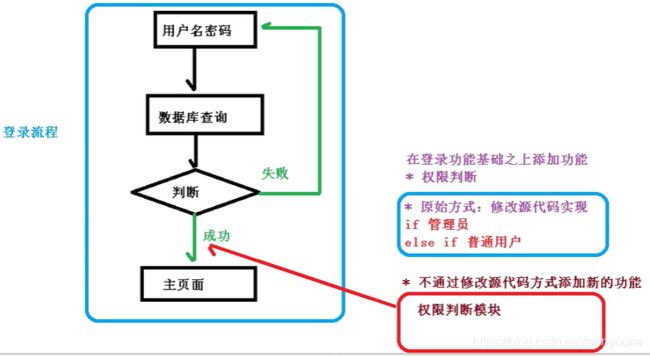
- 底层原理:AOP底层使用动态代理,有两种情况
(1)有接口的情况,使用JDK动态代理(创建接口实现类代理对象,增强类的方法)
(2)没有接口情况,使用CGLIB动态代理(创建子类的代理对象,增强类的方法)
2、AOP—JDK动态代理
JDK动态代理:使用Proxy类里面的方法创建代理对象:java.lang.reflect.Proxy
调用newProxyInstance方法
参数一:类加载器;
参数二:增强方法所在的类实现的接口,支持多个接口
参数三:实现接口InvoationHandler,创建代理对象,写增强的方法
(1)编写JDK动态代理方法
(代码见demo4)
(1)创建接口,定义方法
public interface UserDao {
public int add(int a,int b);
public String update(String id);
}
(2)创建接口实现类,实现方法
package spring5;
public class UserDaoImpl implements UserDao{
@Override
public int add(int a, int b) {
System.out.println("add执行了");
return a+b;
}
@Override
public String update(String id) {
System.out.println("update执行了");
return id;
}
}
(3)使用Proxy类创建接口代理对象
package spring5;
import java.lang.reflect.InvocationHandler;
import java.lang.reflect.Method;
import java.lang.reflect.Proxy;
import java.util.Arrays;
public class JDKProxy {
public static void main(String[] args) {
//创建接口实现类代理对象
Class[] interfaces={UserDao.class};
UserDaoImpl userDao=new UserDaoImpl();
UserDao dao=(UserDao) Proxy.newProxyInstance(JDKProxy.class.getClassLoader(), interfaces,new UserDaoProxy(userDao));
int res=dao.add(1,2);
System.out.println("result:"+res);
}
}
//创建代理对象代码
class UserDaoProxy implements InvocationHandler{
/**1、传递被代理对象到代理类中
UserDaoImpl中的add方法要被增强,所以要把UserDaoImpl的对象传递过去(就是这里的obj)
用有参构造传递
*/
private Object obj;
public UserDaoProxy(Object obj){
this.obj=obj;
}
//这里写增强的逻辑
@Override
public Object invoke(Object proxy, Method method, Object[] args) throws Throwable {
//方法之前
System.out.println("方法之前执行了"+method.getName()+" :传递的参数"+ Arrays.toString(args));
//被增强的方法(obj就是创建的代理对象)
Object res=method.invoke(obj,args);
//方法之后
System.out.println("方法之后执行"+obj);
return res;
}
}
(2)AOP术语
①连接点:类里面可以被增强的方法
②切入点:实际被真正增强的方法
③通知(增强):实际增强的逻辑部分前置通知(增强的方法之前执行) 后置通知 环绕通知 异常通知(方法出现异常会执行) 最终通知(finally)④ 切面:把通知应用到切入点的过程(是一个动作)
(3)AOP操作(准备)
①Spring框架一般都是就AspectJ实现AOP操作
AspectJ不是Spring组成部分,是独立AOP框架,一般把AspectJ和Spring框架一起使用,进行AOP操作
②基于AspectJ实现AOP操作
基于xml配置文件实现
基于注解方式(使用)
a. 切入点表达式作用:知道对哪个类里面的哪个方法进行增强
b. 语法结构: execution([权限修饰符][返回类型][类的全路径][方法名称]([参数列表]))*举例1:对spring5.dao.BookDao类里面的add进行增强
execution(*spring5.dao.BookDao.add(..))//*表示所有的权限修饰符
*举例2:对spring5.dao.BookDao类里面所有的方法进行增强
execution(*spring5.dao.BookDao.*(..))
*举例3:对spring5.dao包里面所有类的所有方法进行增强
execution(*spring5.dao.*.*(..))
(4)AOP操作(AspectJ注解)
①创建类,在类里面定义方法
//被增强的类
public class User {
public void add() {
System.out.println("User add()....");
}
}
②创建增强类(编写增强的逻辑)。在增强类里面创建方法,让不同方法代表不同通知类型
/**
* @Description:增强的类
*/
public class UserProxy {
public void before(){
System.out.println("before....");
}
}
③进行通知的配置
a. 在Spring的配置文件中,开启注解扫描
b. 使用注解创建User和UserProxy对象
c. 在增强类上添加注解@Aspectd. 在spring配置文件中开启生成代理对象
<!-- 开启 AspectJ 生成注解对象
扫描有 @Aspect 注解的类, 有这个注解的就生成代理对象
-->
<aop:aspectj-autoproxy></aop:aspectj-autoproxy>
④配置不同类型的通知
在增强类里面,在通知方法上面添加通知类型注解,使用切入点表达式配置
@Component
@Aspect //生成代理对象
public class UserProxy {
// 相同切入点抽取
@Pointcut(value = "execution(* spring5.aopanno.User.add(..))")
public void pointdemo() {
}
//前置通知,@Before注解表示为前置通知
@Before(value = "execution(* spring5.aopanno.User.add(..))")
public void before(){
System.out.println("before....");
}
// 返回结果之后执行
@AfterReturning(value = "pointdemo()")
public void afterReturning() {
System.out.println("afterReturning....");
}
// 方法之后执行,最终通知,不管有无异常都执行
@After(value = "pointdemo()")
public void after() {
System.out.println("after....");
}
// 异常通知
@AfterThrowing(value = "pointdemo()")
public void afterThrowing() {
System.out.println("afterThrowing....");
}
// 环绕通知
@Around(value = "pointdemo()")
public void around(ProceedingJoinPoint proceedingJoinPoint) throws Throwable {
System.out.println("环绕之前....");
//被增强的方法执行
proceedingJoinPoint.proceed();
System.out.println("环绕之后....");
}
}
// 相同切入点抽取
@Pointcut(value = "execution(* spring5.aopanno.User.add(..))")
public void pointdemo() {
}
⑥有多个增强类对同一个方法进行增强,设置增强类优先级
(假设有另一个类PersonProxy也对add方法做增强)
在增强类上添加注解@Order(数字),数字值越小优先级越高
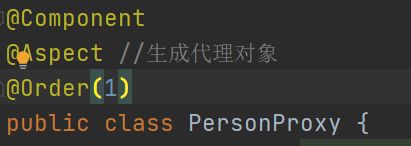
⑦完全使用注解开发
创建配置类,不需要配置xml文件
@Configuration
@ComponentScan(basePackages = {"spring5"})
@EnableAspectJAutoProxy(proxyTargetClass = true)
// 替代配置文件中的 (5)AOP操作(AspectJ配置文件)(较少用)
①创建两个类,增强类和被增强类,创建方法
public class Book {
public void buy(){
System.out.println("buy...");
}
}
public class BookProxy {
public void before(){
System.out.println("before...");
}
}
②在spring配置文件中创建两个类对象
③在spring配置文件中配置切入点
<?xml version="1.0" encoding="UTF-8"?>
<beans xmlns="http://www.springframework.org/schema/beans"
xmlns:xsi="http://www.w3.org/2001/XMLSchema-instance" xmlns:aop="http://www.springframework.org/schema/aop"
xsi:schemaLocation="http://www.springframework.org/schema/beans http://www.springframework.org/schema/beans/spring-beans.xsd http://www.springframework.org/schema/aop https://www.springframework.org/schema/aop/spring-aop.xsd">
<!-- 创建对象-->
<bean id="book" class="spring5.aopxml.Book"></bean>
<bean id="bookProxy" class="spring5.aopxml.BookProxy"></bean>
<!-- 配置aop增强-->
<aop:config>
<!-- 切入点,id随便取名-->
<aop:pointcut id="p" expression="execution(* spring5.aopxml.Book.buy(..))"/>
<!--配置切面,ref是增强类-->
<aop:aspect ref="bookProxy">
<!-- 配置增强作用在具体方法上-->
<aop:before method="before" pointcut-ref="p"/>
</aop:aspect>
</aop:config>
</beans>



